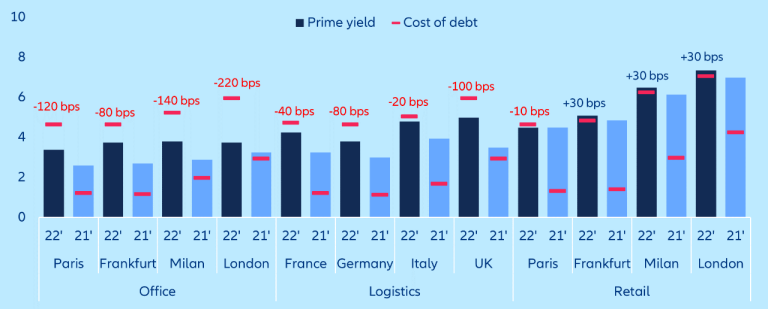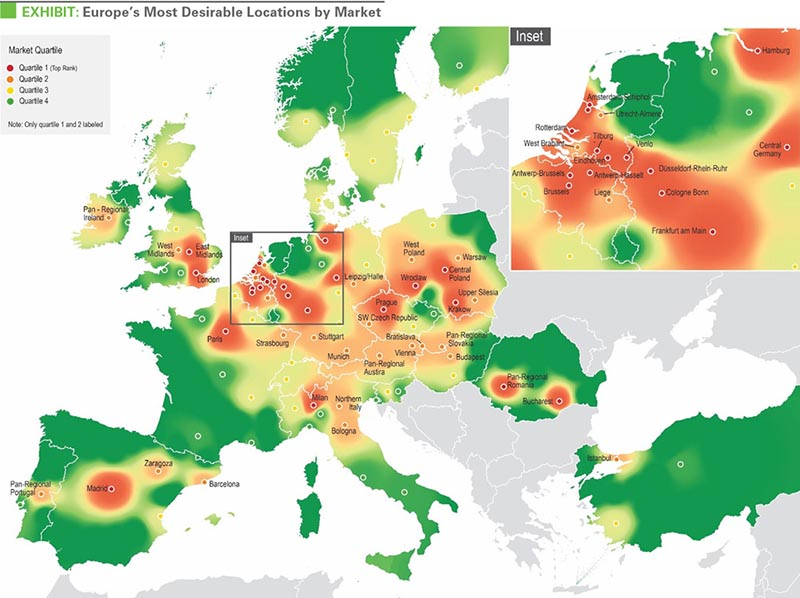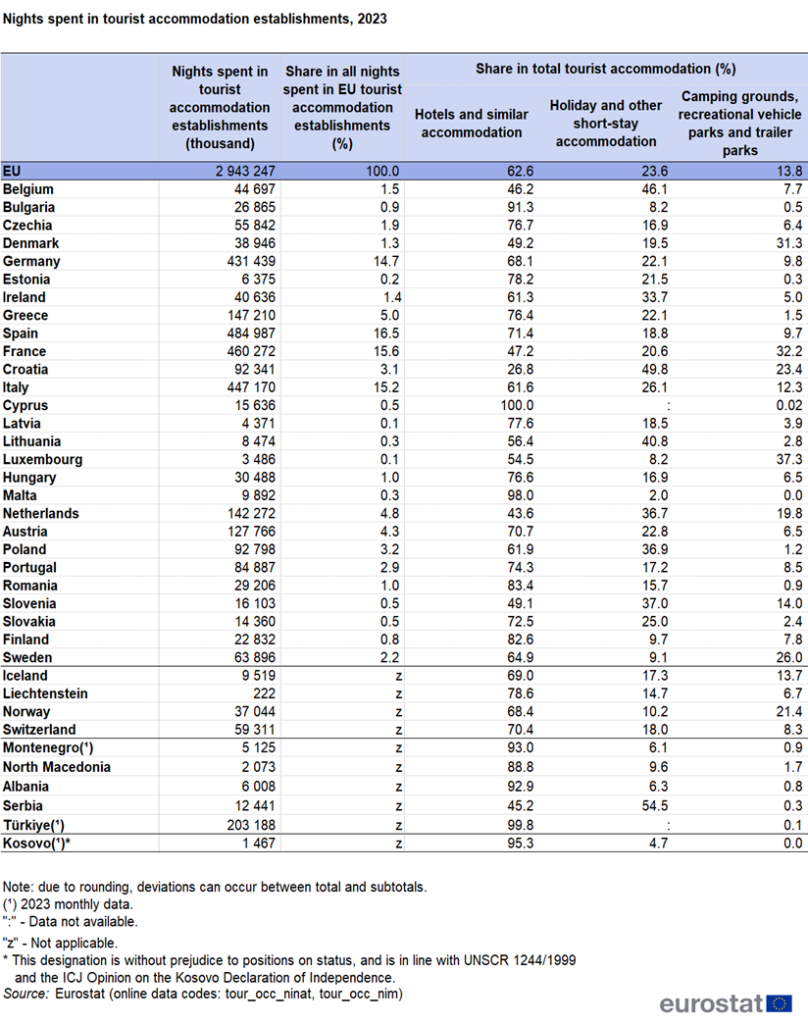Local (European-Specific) Content: Retail Properties in Europe
Objetivos de aprendizagem da lição:
- Understand the business models behind different commercial property types—how retail, office, industrial, and hospitality properties are bought, leased, and managed across Europe.
- Learn the key benefits and risks for each property type, such as high rental yields in prime retail areas like Paris, or growing demand for industrial space near ports like Rotterdam.
- Interpret key data visuals—including yield comparisons, occupancy trends, and geographic desirability maps—to gain insights into market movements and investment potential.
- Explore post-pandemic market shifts, such as how remote work has affected office demand or how e-commerce is reshaping the need for logistics centers in Europe.
12.1 Retail Properties in Europe
Retail properties are commercial spaces used for businesses that sell goods or services directly to consumers. This includes shopping centers, high street retail stores, and standalone shops. Retail property investment in Europe has traditionally been strong in major cities like London, Paris, e Milan, but it is evolving with the rise of e-commerce.
How it Works
Investors purchase or lease retail properties and lease them to businesses. Retail properties in prime European locations, such as Oxford Street in London or Champs-Élysées in Paris, tend to attract well-known brands and generate high rental income. However, the success of retail properties is increasingly tied to foot traffic, which has been impacted by the growth of online shopping.
Key Benefits
- High Rental Yields: Retail properties in major European shopping districts command premium rents due to high consumer footfall and demand from luxury retailers.
- Stability: Long-term leases with established retail brands offer stable income for investors. In cities like Vienna e Barcelona, retail tenants often sign multi-year leases.
- Capital Appreciation: Prime retail properties, particularly in popular tourist destinations, often see significant appreciation over time.
Challenges
- E-commerce Competition: The growth of e-commerce has reduced demand for traditional retail spaces, particularly in smaller cities. Investors need to carefully assess location and tenant mix to mitigate this risk.
- Changing Consumer Behavior: Retail properties must adapt to changes in consumer preferences, such as the shift towards experiential shopping and services over traditional brick-and-mortar stores.
- Vacancy Risk: In some European cities, there has been a rise in vacant retail spaces as businesses close or relocate, particularly in regions hit hard by economic downturns.
Figura: Prime Yields vs. Cost of Debt in European Real Estate Markets (2021–2022)
Descrição:
This bar chart compares prime yields (dark blue bars) and cost of debt (red markers) across three real estate sectors—Office, Logistics, and Retail—in major European cities, including Paris, Frankfurt, Milan, London, and others. The data is segmented by years 2021 (’21) and 2022 (’22), with changes in basis points (bps) highlighted above each segment. Notable trends include significant decreases in prime yields in sectors like Office e Logistics between 2021 and 2022, with reductions ranging from -20 bps to -220 bps. Conversely, in Retail, select cities (Frankfurt, Milan, London) show a slight increase in yields (+30 bps). The chart emphasizes the evolving relationship between investment returns and financing costs in key European markets.
Principais conclusões:
- Office Sector: Yields declined significantly across cities like Paris (-120 bps) and Frankfurt (-80 bps), reflecting increasing property valuations.
- Logistics Sector: The most substantial yield compression was observed in cities like France (-220 bps) and Germany (-80 bps), indicating high demand in this asset class.
- Retail Sector: Minor increases in yields (+30 bps) in cities like London and Frankfurt suggest a modest rebound in retail investments.
- O cost of debt remained relatively stable in most sectors, creating a narrowing margin between prime yields and financing costs.
- Paris and Milan showed strong performance across all asset classes, with competitive yields and manageable debt costs.
Application of Information:
This data is valuable for real estate investors seeking insights into European market trends. The narrowing spread between yields and debt costs underscores the importance of identifying high-growth sectors like Logistics for better returns. For learners, this chart illustrates how shifts in market demand e interest rates affect real estate profitability, helping them assess market timing and sector-specific investment opportunities.
12.2 Office Properties in Europe
Office properties are commercial spaces leased to businesses and organizations for administrative work. European cities such as Frankfurt, Zurich, e London are known for their thriving office markets, especially in financial and business districts.
How it Works
Investors purchase or lease office buildings and rent them to companies. In cities like Brussels (home to many EU institutions) and Paris, office properties attract multinational corporations, offering long-term, stable rental income. The demand for office space is driven by the presence of large business sectors, government institutions, and tech companies.
Key Benefits
- Long-Term Leases: Office properties often have longer lease terms (5-10 years) compared to residential or retail, providing more stable income for investors.
- High-Quality Tenants: In business hubs like Berlin e Amsterdam, office spaces are typically leased to multinational corporations and government entities, reducing the risk of tenant defaults.
- Capital Growth: European office markets in cities like Munich e Stockholm continue to experience capital appreciation due to strong demand and limited supply.
Challenges
- Remote Work Trend: The shift towards remote work following the COVID-19 pandemic has reduced demand for traditional office spaces in some cities. Investors must assess the long-term viability of office spaces, particularly in secondary markets.
- High Maintenance Costs: Office buildings require significant upkeep, especially in older properties. Renovations to maintain modern standards (e.g., smart buildings, energy efficiency) can be costly.
- Market Saturation: In some cities like Dublin e Frankfurt, there is an oversupply of office space, leading to higher vacancy rates and reduced rental income potential.
Figura: European Office Occupancy Rates by City
Descrição:
This figure compares the office occupancy rates across various cities, including Madrid, Paris CBD, London West End, Stockholm, Warsaw, Prague, London City, Dublin, New York, Los Angeles, and San Francisco, over three distinct time periods: June 2022, February 2023, and September 2023. The bar chart uses three colors to represent these time periods: blue for June 2022, orange for February 2023, and black for September 2023. Each city’s occupancy rate is depicted as a percentage, with Madrid and Paris CBD consistently showing the highest rates, while cities like Los Angeles and San Francisco have significantly lower rates. The graph highlights trends in how occupancy rates have changed over time, illustrating recovery or stagnation in office usage in various regions. This allows viewers to compare and contrast performance in Europe and major global cities.
Principais conclusões:
- Madrid e Paris CBD consistently have the highest office occupancy rates across all time periods, surpassing 60%.
- Los Angeles e San Francisco have the lowest rates, with occupancy stagnating below 40% throughout.
- European cities generally show higher occupancy rates compared to North American cities, highlighting a regional difference in post-pandemic recovery.
- The data demonstrates growth in occupancy rates between June 2022 and September 2023 for most cities, though the rate of growth varies.
- Stockholm e Warsaw show steady improvement, reaching mid-tier occupancy levels.
- The graph provides insights into how office usage is evolving globally, reflecting regional economic and cultural differences.
Application of Information:
Understanding office occupancy trends is critical for real estate investors, urban planners, and businesses analyzing commercial property performance in different regions. For investors, this data helps identify cities with higher demand for office spaces, guiding decisions about property investments ou market entry strategies. Additionally, the trends in North America versus Europe illustrate broader economic recovery patterns, which can influence investment decisions in related sectors.
12.3 Industrial Properties in Europe
Industrial properties are used for manufacturing, storage, and distribution. These properties are crucial for sectors like logistics, e-commerce, and manufacturing. The rise of e-commerce in Europe has spurred demand for warehouses and distribution centers, particularly near major cities like Rotterdam, Hamburg, e Madrid.
How it Works
Investors purchase or lease industrial properties, such as warehouses, factories, or logistics hubs, and rent them to businesses in sectors like manufacturing, distribution, and e-commerce. Proximity to transportation hubs (airports, highways, seaports) is a key factor in determining the value of industrial properties.
Key Benefits
- Growing Demand: The growth of e-commerce has increased the need for logistics centers and warehouses. Industrial properties near ports in Rotterdam ou Antwerp are in high demand due to the rise of online shopping and global trade.
- Lower Management Costs: Compared to retail or office properties, industrial properties generally have lower maintenance and management costs. Tenants are often responsible for the upkeep of the property.
- Long-Term Leases: Industrial leases are typically long-term, providing stable rental income. Tenants, particularly in logistics, tend to sign 10- to 15-year leases due to the cost of setting up operations.
Challenges
- Location Dependent: The success of industrial properties depends heavily on their location. Properties near transportation hubs or in industrial zones, such as those around Milan ou Frankfurt, are more desirable than those in remote areas.
- Economic Sensitivity: Industrial properties are more sensitive to economic cycles, as demand for manufacturing and storage space can decrease during economic downturns.
- Environmental Concerns: Industrial properties must adhere to environmental regulations, particularly in countries like Germany e Sweden, which have strict guidelines on emissions and waste management.
Figura: Europe’s Most Desirable Locations by Market
Descrição:
This map highlights Europe’s most desirable markets for real estate, categorized into quartiles based on market desirability. The red areas represent the top-ranked markets (Quartile 1), while yellow, light green, and dark green areas represent Quartiles 2, 3, and 4, respectively. Prominent locations like London, Paris, e Frankfurt are among the most desirable, shown in red. The map provides an inset zooming into Central Europe, where areas like Düsseldorf e Cologne-Bonn also demonstrate high desirability. This geographic visualization allows viewers to quickly identify prime regions for investment in real estate across Europe.
Principais conclusões:
- Red regions (Quartile 1) are the most desirable markets, including major cities like Paris, London, e Frankfurt, indicating strong demand for real estate investments.
- Quartile 2 (Yellow areas) still represents high-value markets, including regions in Germany, Netherlands, e Central Poland.
- Southern and Eastern European regions, such as Romania e Bulgaria, tend to fall into Quartiles 3 and 4, indicating less desirability for real estate investment but potential for future growth.
- The map offers a clear geographic breakdown of European markets, segmented by their real estate potential.
- Zoomed-in areas help to better analyze market conditions in highly competitive regions like Central Europe.
Application of Information:
This data helps real estate investors e businesses pinpoint the most promising regions for investment based on market desirability. Investors can use this information to focus on high-demand areas like London ou Paris for stable returns or consider less competitive markets for higher-risk, higher-reward opportunities. It also aids in strategic decision-making for expanding businesses in Europe by aligning location choices with market dynamics.
12.4 Hospitality Properties in Europe
Industrial properties are used for manufacturing, storage, and distribution. These properties are crucial for sectors like logistics, e-commerce, and manufacturing. The rise of e-commerce in Europe has spurred demand for warehouses and distribution centers, particularly near major cities like Rotterdam, Hamburg, e Madrid.
How it Works
Investors purchase or lease industrial properties, such as warehouses, factories, or logistics hubs, and rent them to businesses in sectors like manufacturing, distribution, and e-commerce. Proximity to transportation hubs (airports, highways, seaports) is a key factor in determining the value of industrial properties.
Key Benefits
- Growing Demand: The growth of e-commerce has increased the need for logistics centers and warehouses. Industrial properties near ports in Rotterdam ou Antwerp are in high demand due to the rise of online shopping and global trade.
- Lower Management Costs: Compared to retail or office properties, industrial properties generally have lower maintenance and management costs. Tenants are often responsible for the upkeep of the property.
- Long-Term Leases: Industrial leases are typically long-term, providing stable rental income. Tenants, particularly in logistics, tend to sign 10- to 15-year leases due to the cost of setting up operations.
Challenges
- Location Dependent: The success of industrial properties depends heavily on their location. Properties near transportation hubs or in industrial zones, such as those around Milan ou Frankfurt, are more desirable than those in remote areas.
- Economic Sensitivity: Industrial properties are more sensitive to economic cycles, as demand for manufacturing and storage space can decrease during economic downturns.
- Environmental Concerns: Industrial properties must adhere to environmental regulations, particularly in countries like Germany e Sweden, which have strict guidelines on emissions and waste management.
Figura: Nights Spent in Tourist Accommodation Establishments, 2023
Descrição:
This table shows the total number of nights spent in tourist accommodations across European Union countries and selected neighboring regions in 2023, measured in thousands. It also breaks down the data into percentages representing the share of nights spent in three types of accommodations: hotels and similar, holiday and other short-stay accommodations, e camping grounds/recreational parks/trailer parks. For instance, Spain e France report the highest number of nights spent, while smaller countries like Malta e Luxembourg contribute significantly less. The data also highlights variability in preferences for accommodation types, with countries like Bulgaria showing a heavy preference for hotels, while France e Germany show more diverse usage across categories.
Principais conclusões:
- France leads with 15.6% of the total share of nights spent in EU accommodations, followed closely by Spain e Italy.
- Bulgaria has the highest share (91.3%) of nights spent in hotels and similar accommodations, showcasing a preference for structured lodging.
- France e Germany exhibit diversity, with significant shares in camping grounds and trailer parks.
- Smaller countries, such as Malta e Luxembourg, have a negligible share of total EU tourist nights, reflecting their smaller tourism capacities.
- Camping grounds and recreational parks are popular in Northern European countries like Sweden, where they make up a significant portion of stays.
Application of Information:
This data is valuable for investors in the hospitality and tourism industry by showing where demand for different accommodation types is highest. It also provides insights into regional preferences, allowing businesses to align their strategies with market demands. For example, investors looking at Bulgaria might prioritize hotel development, whereas in France, focusing on diversified accommodation types could yield better returns. Understanding these trends also helps in evaluating tourism growth across countries, a key factor for real estate and infrastructure investment.
Informações importantes da lição:
- Retail properties in cities like London e Paris benefit from high foot traffic and long-term leases, but face pressure from e-commerce and changing consumer behavior.
- Office properties in hubs like Frankfurt e Brussels offer stable, long-term income from corporate tenants. However, they are vulnerable to shifts like remote work and require higher maintenance investment.
- Industrial properties, especially in cities near major ports (Rotterdam, Hamburg), are experiencing strong demand due to the growth of logistics and e-commerce, offering long leases and lower maintenance costs.
- Hospitality properties see high demand in tourism-heavy countries like Spain, France, e Italy, with growing opportunities in both hotels e alternative accommodations (e.g., short-stay apartments, camping). However, they are seasonally sensitive e depend on tourism trends.
- Data such as prime yield spreads, occupancy rates, e tourist nights are crucial for identifying which cities and sectors are poised for growth or facing saturation.
Declaração de Encerramento
Commercial real estate in Europe presents a wide range of opportunities and challenges. By understanding the characteristics of each asset class, investors can build well-informed strategies based on location, tenant profiles, economic trends, and sector-specific demand.





